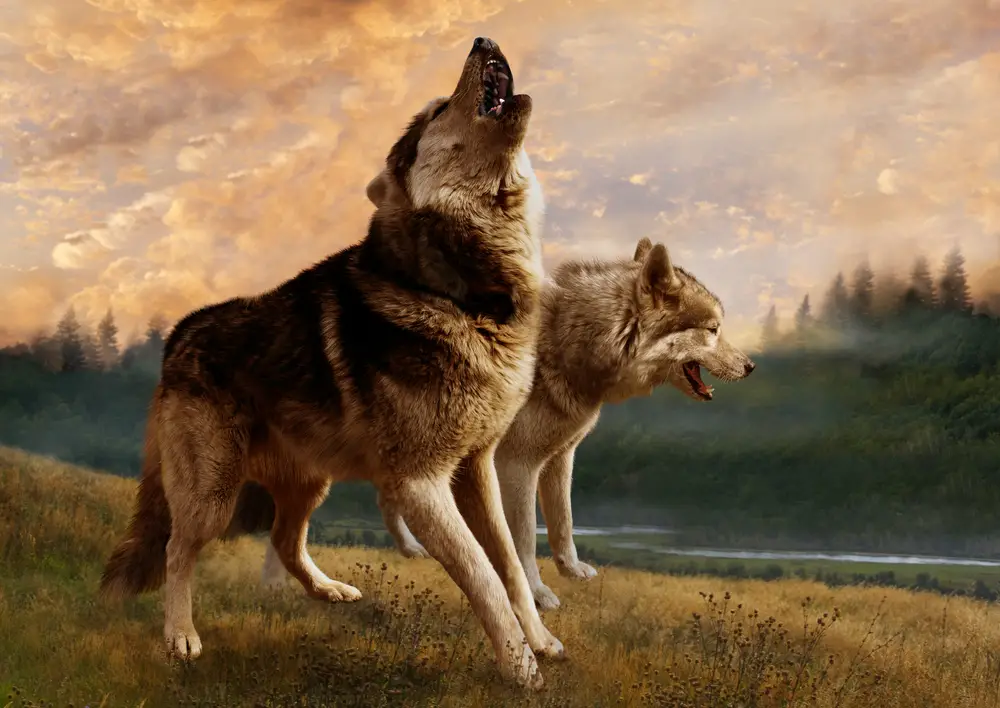The wolf, also referred to as the gray wolf, is a large canine native to North America and Eurasia. Wolves typically live in the remote wilderness, such as forests, woodland and in the mountains.
They are fascinating creatures. As much as they look like our canine companions, they are ferocious beasts and fierce hunters.
So how do wolves survive, hunt and where do they live? This guide will walk you through how wolves survive in the wild, and what the wolf pack mentality is.
You may have heard of the term a lone wolf, and wondered where this saying comes from. Well, wolves do not actually live alone as they travel in packs!
Each wolf will have a specific role, and you will have an Alpha wolf and a Beta wolf.
How do wolves live in the wild?
In the wild, wolves will live in woodlands and rural areas, building dens in the ground for their young. When fully grown, wolves will actually live, hunt and travel in packs called a wolf pack.
These will typically consist of about 6-10 wolves, and they will roam, hunt and work together to find their prey. Wolves naturally hunt prey much larger than them, so they will need a few wolves to cooperate to take down animals like deer, elk and moose.

As a pack, the wolves will travel for miles and can even go up to 12 miles in a single day. By night, they will take shelter in caves, or between rocks, but they always stay together.
They are highly sociable animals, and have a specific hierarchy within their packs, with an alpha wolf and a beta wolf.
The alpha wolf is the leader of the pack, and the other wolves will follow suit. There can be two alpha wolves in a pack, and these will normally be the breeding pair, so a male and a female wolf. These lead the pack during the hunt and will eat first once a kill has been made.
The other wolves in the pack can often be the offspring of the two leading wolves, who will follow suit and know their place in the pecking order.
What is a Beta wolf?
The term Beta wolf refers to the wolf that is sort of second in command. It is the highest rank in the wolf pack, just second to the Alpha wolves. The beta wolf will typically be the highest ranking male wolf after the Alpha.
The beta wolf will also be able to command the rest of the pack, except from the alphas, and it is assumed that the beta wolf would take command over the pack if something happened to the current alpha.
Wolf ranks and pecking order
Wolves are pack animals, and they often live with family members or with wolves of the same bloodlines. As such, there is a natural rank and pecking order of the wolves, as some assume control over the others, and some fall back and submit.
At the top of the rank, you will find the alphas. These will be a male and female that are a breeding pair, and will assume control of the rest of the pack.
Then you will have the beta male, and often a female too. The betas are responsible for the pack when the alphas are busy, and they must also keep the pack in line.
In addition, there will be mid-ranking wolves, which are often related to the alphas and betas. These could be aunts and uncles of the offspring.
You will also have young or adolescent wolves in the pack, that will most likely be the offspring of the alphas, along with a male and female omega wolf.
The omega wolves are the lowest ranking wolves, and will have no power, authority, and will feed last. The omega wolves often live off the scraps of the hunt, and are not permitted to mate.
Therefore, some omega wolves will leave the pack, become lone wolves or try to join a different pack.
Sometimes, the structure of the wolf pack can change, and a beta, or another wolf can challenge the alpha for dominance and pack leadership.
If the alpha fails, then they will be ostracized from the pack, and they will most likely become a lone wolf until they find another mate and start a new pack.
Contrary to popular belief, the wolf pack mentality is not about power or authority. Yes, there are alphas, and second in command betas, but wolves live and cooperate as a unit.
They raise their young together, hunt together, defend territory together and care for each other as a family.

